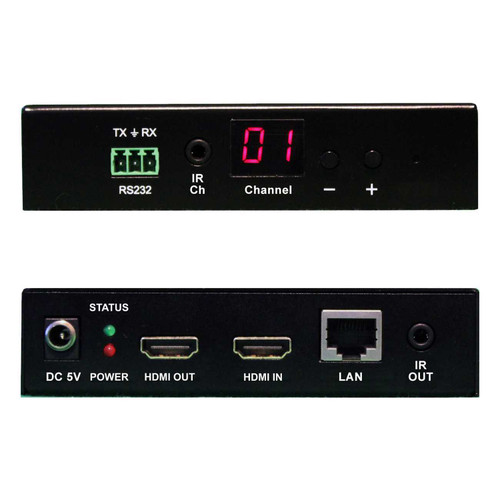The WolfPack™ POE HDMI Transmitter over IP with USB transmits 1080p HDMI video/audio signals up to 100 meters (330 feet) using a single CAT-5e/6 cable, eliminating the need for a universal power supply. It adapts to network bandwidth with internal JPEG video compression and supports video walls up to 16x16 (256 TVs) using H.264 or H.265 technology.The system ensures high-quality, long-distance transmission of HDMI sources with an equalization control switch on the receiving unit. This setup provides cost-effective flexibility for HDCP-compliant devices.
- Wireless iPad/iPhone control
- Includes a Built-in Video Wall Processor supporting up to a 16x16 (256 TVs)
- Engineered using the H.265 protocol for the best picture
- Zero Latency
- 100ms Switching Time
- Separate audio
- Includes a Drag-N-Drop Built-in Video Wall Processor supporting up to a 16x16 (256 TVs)
- POE design so it doesn't require AC adapters
Our WolfPack™ POE HDMI Transmitter over IP with USB uses TCP/IP network technology and can se4nd a full HD HDMI signal transmitted and distributed to 100m or 330 feet. The local and remote units can be connected for a point-to-point connection, or through VLAN isolation on a managed network switch for a multipoint-to-multipoint configuration. However, for the multipoint-to-multipoint configuration the gigabit Ethernet switch must support the IGMP communications protocol.
POE HDMI Transmitter over IP with USB Features:
- Transmitter (Encoder) supports an RJ45 Input & HDMI output
- Internal Video Wall function
- Supports both H.264 and H.265 protocols
- POE Design
- Supports audio de-embedding output.
- Allows video, audio, and RS232 signals to be routed together or separately.
- Streams HDMI signal over an IP network.
- End-to-End Time Latency with Transmitter:
- About 50 ms (Low latency mode)
- About 250 ms (High quality mode)
- The companion Receiver supports resolutions up to 1920 x 1080@60Hz.
- This Receiver offers auto scaling with output resolutions supported from 480p@60Hz to 1920 x 1080@60Hz scaling based on the EDID of display.
- Able to output two IP streams.
- One large IP stream supports streaming resolution from 480p@60Hz to 1920 x 1080@60Hz to view a video on the decoder side.
- The other small one supports streaming resolution 352x288@5Hz to easily preview a video on a third-party device (e.g., tablet).
- Features video wall configurations up to 16 x 16.
- Available API interface for third party control system integration offers control through IP control box, a PC configuration, and an iPad.
- Supports firmware upgrade through Maintain Tool.
- Supports EDID import to encoder and export from display to decoder.
- Supports CEC one-touch-play and standby commands to power on and off the display and reports the CEC commands that come from display to IP control box.
- Supports decoder to turn off the output through API when no source is detected.
- Support HDCP 1.4.
- Configurable encoding bit rate up to 30 Mbps.
- Supports seamless 100ms switching.
- Supports PoE to be powered by power source equipment.
- Supports Auto IP: Automatically generates a dynamic IP address at startup in the absence of a DHCP server.
- Supports communications protocols such as H.264, H.265, TCP/IP, Telnet, UDP and IGMP.
Why not buy this WolfPack POE HDMI Transmitter over IP with USB today?
POE HDMI Transmitter over IP with USB Specs:
- Resolutions Supported:
- 640 x 480@60Hz
- 480p@60Hz,
- 576P@50Hz,
- 800 x 600@60Hz,
- 1024 x 768@60Hz,
- 720p@50Hz, 720p@60Hz,
- 1280 x 800@60Hz,
- 1280 x 1024@60Hz,
- 1366 x 768@60Hz,
- 1400 x 1050@60Hz,
- 1440 x 900@60Hz,
- 1680 x 1050@60Hz,
- 1920 x 540@60Hz,
- 1080p@24Hz,
- 1080p@25Hz,
- 1080p@30Hz,
- 1080p@50Hz, 1080p@60Hz
- HDMI 1.3, HDCP 1.4
- POE or can be powered using provided power supply
- No need to do the IP settings, plug and play
- WEB GUI control for IP address, video wall, EDID etc settings
- Supports to rename the sources and displays
- 3-pin audio de-embedded on TX and RX
- EDID preset/learning
- Low latency About 50 ms (Low latency mode) About 250 ms (High quality mode)
- Video Wall mode and matrix switch both modes
- Supports iPad APP control with preview function
POE HDMI Transmitter over IP with USB Set Includes:
- 1 - HDMI Over Ethernet Transmitter unit
- 1 - 12V 1A power adapter (Also can be used in non-POE Applications)
- 1 - User manual
POE HDMI Transmitter over IP with USB Specs:
- Input TMDS signal: 1.2 volts (peak-to-peak)
- Input DDC signal: 5 volts (peak-to-peak)
- HDMI Connector: 19 pin type female connectors
- RJ-45 Connector
Why not buy this WolfPack POE HDMI Transmitter over IP with USB today?

Reasons To Buy an HDTV Supply WolfPack Product
Control
Q: This product has CEC, what is CEC?A: This product features CEC (Consumer Electronics Control) allowing your HDTV's remote to manage up to ten devices that are connected via HDMI (such as Blu-ray Disc players or home theater receivers) with no special programming needed. For example, you can use your remote to turn on your TV, your player, and your receiver at the same time, and adjust the system volume with one button. All devices must support CEC, though.
Most major TV manufacturers now support CEC, and an HDTV with HDMI 1.3 will have the technology. Manufacturers call it by different names; LG Electronics, for instance, calls its implementation SimpleLink, whereas Toshiba calls its version CE-Link. Interoperability isn't mandatory, so some manufacturers limit control to their own products; Sony, for one, allows only Sony-to-Sony communication.
- One Dedicated VLAN for the devices below
- No other network appliances in the VLAN
- Not the same as an existing "Multicast VLAN"
- Unique subnet
- No other network appliances in the subnet
Why not buy this WolfPack POE HDMI Transmitter over IP with USB today?
A: Yes. The network switches can be cascaded and still act as a large matrix.
Q: Is it a WEB GUI control or PC software
A: It is a PC control software-based system for configurations like CEC settings, resolution, image rotating, etc
Q: How do you setup the video wall and can it support a 16x16 video wall 256 TVs?
A: For the video wall set up, it can done it in seconds using the iPad app. The video wall maximum can up to 16x16 with 256 TVs
Q: How do you change the IP and MAC address of the transmitters and receivers?
A: You can set up the IP and MAC on the iPad app or PC control software, but we recommend using the automatic IP and MAC address, so it can support plug and play.
Q: The Transmitters and Receivers both have Audio out on the receiver can the audio be matrixed such as Receiver A sends audio out to Receiver B, if using the audio out?
A: The audio out on both the RX and TX are the corresponding audio with the video so its audio function is only an extract function from the video and is not able to do as an audio matrix.
Q: On the IP control box there are (2) LAN ports, would that be for 2 separate LANs?
A: We will only need to use the LAN 1 for the controlling & settings and for the broadcast version:
- LAN1 (AV/POE): To connect with the network switch use the PC control software to control this system
- LAN2 (C): To connect with the network switch this is used for a 3rd party to use the IP control this system
Q: What is the distance with POE in and out?
A: With the POE, the input can up to 100m (330 ft) at 1080p@60Hz and the output also is 100m (330 ft)
Q: What is the distance without POE using the AC adapters in and out?
A: It is also the same distance as the POE distance as in and out both are 100m (330 ft)
Q: What type of UTP cable do you recommend?
A: As it's used for video signal transmission, we recommend using the STP 868B cable
Q: Can you use CAT6 - 5E - 6 and 7 and is there a difference in length of cables?
A: We did the tests here with the CAT6/CAT6/Cat6/Cat7 cable and the CAT6 and CAT7 are the best and can reach a distance of 150m with POE
Q: Please give us an explanation of when the large and small streaming resolutions would be used?
A: The highest resolution can up to 1080P@60Hz, the lowest resolution is 680x480@60Hz but that resolution can't support the IP camera decoding
Q: When do you use the control box?
A: There are 2 situations where you will need to use the control box:
- When using the broadcast version (unlimited TX and RX)
- When needing to use a 3rd-party to control this system (IP/ RS232)
What does the PC Configurator do?
A: The PC control software is for the resolutions, CEC, RS232, image rotating and RX/TX IP settings
Q: Does the iPad control require a wireless router?
A: Yes, it will need a WIFI router connected to the same system
Q: In the diagram in the manual, it shows the IP control box with only an Internet connection, does a PC plug into it?
A: Yes, the control PC uses a LAN cable connected to the same network switch
Q: You also recommend Managed POE switches, correct?
A: We tested on several POE network switches and so far both of the managed POE, or the non-managed POE network are working well. But the managed network switch is more stable and it's fanless which is quieter.



















